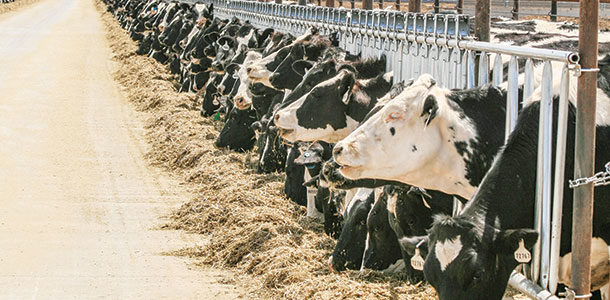The death of an adult cow on a dairy is a bad event. For a cow to die on a dairy, something went terribly wrong for that individual animal. In addition, from a financial point of view, this is the worst way for a cow to be removed from production. There is no question: Every dairy producer would agree adult cow death losses should occur as infrequently as possible.
Over the last couple of decades, however, death losses on dairies have increased substantially. A literature review suggests that dairy death losses hovered around just 3 percent 30 to 40 years ago. Over the last decade, it appears these numbers have risen to an average of 6 to 10 percent. This number is typically calculated on a farm as the number of dead cows annually divided by the average herd inventory for that year.
Unfortunately, there has been very little monitoring of average herd death loss, so published and validated numbers are not readily available. There are no well-established benchmarks or targets for producers to compare.
However, the national dairy survey conducted by the USDA:APHIS:VS National Animal Health Monitoring System shows a steadily increasing rate of adult cow losses from 1996 through 2007. Review of DHIA records from across the country confirm this trend, with typical death loss rates around 6 to 8 percent.
If those are the averages, then some farms have much lower death rates while other farms are notably higher. Indeed, our studies confirm that some farms consistently lose only 2 to 3 percent of their cows while other farms experience losses around 12 to 14 percent.
If dairy producers would all agree that an adult cow death is a tragic event, how can it be that death losses can be rising but very little attention has been paid to the issue? After discussing this with many dairy producers and veterinarians, I think the answer is simple. As a dairy producer told me years ago when we were examining a dead animal and regretting its loss, “If you want to never have a dead cow, don’t own cows.”
We all know that dairies are complex entities, and that dairy management is a complex and ever-changing challenge. Producers know something goes wrong eventually, and they are willing to accept that some of their animals will die.
Therefore, a death loss is seen as unfortunate but a fact of life and doing business. Unfortunately, it is easy for this acceptance of a reality to blend into a complacency that does not recognize an increase in occurrence.
On most dairies, it is uncommon that death losses are investigated unless a number of cows die in a very short period of time. The USDA survey in 2007 documented that only 4.4 percent of all cows that die on dairies are subjected to postmortem examination (necropsy). This means valuable information that might be used to change herd management or prevent future losses is rarely explored.
There appears to be a circular problem that occurs in the interaction between dairy producers and their veterinarians. On the one hand, dairy producers record death losses and often enter a presumed cause of death into their record systems.
The assumption is that the dairy producer knows why a cow died. Veterinarians, for their part, often see themselves as service providers. If a producer does not ask them to examine dead cows or look for their advice, then they turn their attention to other areas where their attention is valued, such as reproduction or mastitis problems.
Dairy producers seem willing to believe they don’t need the veterinarian’s help, while veterinarians don’t see producers looking for input on death loss analysis.
Our studies show that producers’ assessment of cause of death is often flawed. This makes sense because the producer is forming a judgment based on a limited amount of information. Certainly, some death losses do not warrant a full necropsy.
For a cow that is euthanized due to an accident and fractured leg, the cause of death and potential means to prevent future losses are very clear. Alternatively, for a cow that died spontaneously without a prior diagnosis, our studies suggest that a producer may list a cause of death correctly only about one-third of the time. A lot can be learned from a properly conducted postmortem examination.
If a producer does not see death losses as a major issue and is not prepared to make management changes to decrease preventable deaths, then our current course of action, with very little pursuit of information about causes of death, is probably fine.
I would rather suggest that information is a very powerful tool. Knowing why cows die can help make management adjustments that not only decrease death loss but also direct improvements in animal health in a more general sense.
Many cows get sick, are treated and survive, and a dead cow is just an example of the extreme case. Knowing why some cows die can also help you determine that there are significant subclinical disease risks on the dairy that can be pursued with other testing or observation.
The following are some recommendations I hope every dairy producer takes to heart. First, since death loss is the worst way to lose a cow, it is well worth producers’ time to carefully evaluate their rate of loss. While dairies commonly have death losses in the high single digits, some producers are well below or well above this rate.
If an individual dairy has an annual death loss between 2 and 3 percent, it suggests they are doing a lot of things right. Losses above this can be improved, and losses greater than 10 percent are crippling to dairy profitability and suggest some serious problems with animal health.
I believe dairy producers should have a serious discussion with their veterinarian about evaluating death losses and also developing a strategy for routine necropsy of dead cows and calves. It is highly beneficial to have dairy workers involved in the process.
There is a lot of information and productive discussion that takes place when evaluating the tracks of disease and the cause of death. The people on a dairy involved in animal care have way more contact with sick cows than either the veterinarian or farm managers.
In many cases, they can provide information to the veterinarian that is unavailable from any other source. In turn, veterinarians can help open workers’ eyes to the end effect of disease processes, which can help them become better animal caregivers.
Tracking the information derived from a postmortem examination is an important challenge. Traditionally, we have listed the cause of death using generic descriptors that refer to an organ system, such as “respiratory death” or “GI death.”
These descriptors are very weak when records are later reviewed because it is difficult to determine what the chain of events was that led to that problem. Therefore, it is hard to make meaningful management changes with this information.
We recommend modifying the information system, even if this only includes hard-copy records. While gathering information about the cause of death, it can often be determined that a cow was identified too late in a disease process, treatment was delayed, poor decisions were made or the problem originated with a bad dystocia delivery, for example.
These are all correctable problems if they are identified. Ideally, the cause of death should be categorized in a way that an owner can use to make alternative management decisions.
Everyone knows that a dead cow is a bad outcome. In the dairy industry, we need to re-think how seriously we take death losses, how avidly we study those losses and how we can take small steps to improve animal health and well-being to decrease these losses. PD
Photo by PD staff.

Frank Garry
Professor
Integrated Livestock Management
Colorado State University







